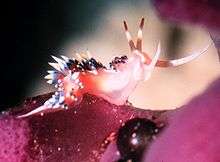Caloria indica
Caloria indica is a species of sea slug, an aeolid nudibranch, a marine gastropod mollusc in the family Facelinidae.[2]
| Caloria indica | |
|---|---|
 | |
| Scientific classification | |
| Kingdom: | |
| Phylum: | |
| Class: | |
| (unranked): | clade Heterobranchia clade Euthyneura clade Nudipleura clade Nudibranchia clade Dexiarchia clade Cladobranchia clade Aeolidida |
| Superfamily: | |
| Family: | |
| Genus: | |
| Species: | C. indica |
| Binomial name | |
| Caloria indica | |
| Synonyms[2] | |
| |
Description
The size of the body varies between 25 mm and 50 mm.
Distribution
This species was described from Ambon Island, Indonesia. It occurs in the Indo-West Pacific from East Africa to Hawaii; also as an invasive species in the Israeli part of the Mediterranean Sea, first recorded in the late 1980s and then again in 2016.[3][4][5][6]
gollark: How does Cthuluscript\™ work?
gollark: You used the d-word!
gollark: =tex hydrogen hydroxide
gollark: =tex dihydrogenmonoxide
gollark: =tex lyriclyisbad
References
- Bergh L. S. R. (1896). "Eolidiens d'Amboine. Voyage de MM. M. Bedot et C. Pictet dans l'Archipel Malais". Revue Suisse de Zoologie 4: 385-394, Plate 16.
- Gofas, S. (2005). Caloria indica (Bergh, 1896). In: MolluscaBase (2016). Accessed through: World Register of Marine Species on 2016-12-21.
- Rudman, W.B., 1999 (March 4) Phidiana indica (Bergh, 1896). [In] Sea Slug Forum. Australian Museum, Sydney.
- Gat G., (1993). Flabellina rubrolineata (O'Donoghue) and Phidiana indica (Bergh) (Nudibranchia: Aeolidioidea), two new Lessepsian immigrants in the Eastern Mediterranean; Journal of Molluscan Studies 59(1): 120
- Zenetos A., Gofas S., Russo G. & Templado J., (2004). CIESM Atlas of exotic species in the Mediterranean. 3. Molluscs (F. Briand, ed.) CIESM Publishers, Monaco 376 p
- Shevy B-S Rothman; Henk K. Mienis; Bella S. Galil (2017). "Alien facelinid nudibranchs in the Eastern Mediterranean: first report of Phidiana militaris (Alder and Hancock, 1864) and report of Caloria indica (Bergh, 1896) 30 years after its previous sighting". BioInvasions Records. 6 (2): 125–128. doi:10.3391/bir.2017.6.2.06.
External links
- "Phidiana indica". Gastropods.com. Retrieved 15 January 2019.
- NCBI
- Photos of Caloria indica on Sealife Collection
| Wikimedia Commons has media related to Caloria indica. |
This article is issued from Wikipedia. The text is licensed under Creative Commons - Attribution - Sharealike. Additional terms may apply for the media files.